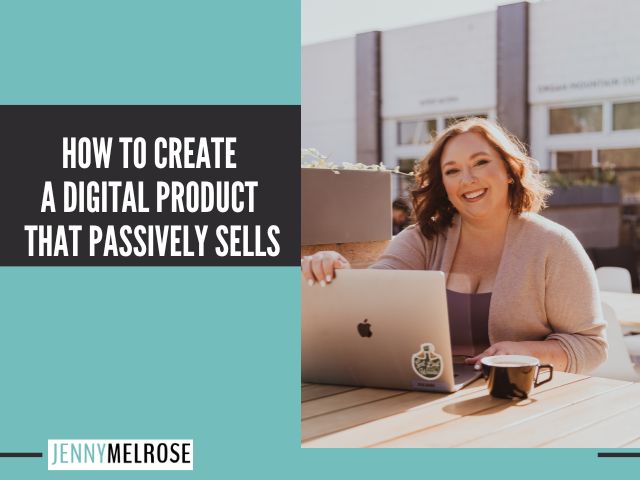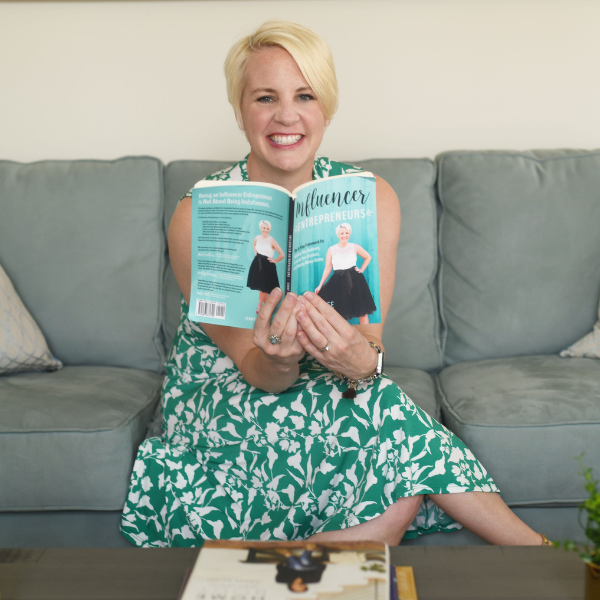Digital products can exponentially increase your income. Learn how to create digital products that you can earn you more money in your business.
IE 357: How to Create a Digital Product that Passively Sells with Molly Keyser

Molly dropped out of college to start a photography business and grew it to over six figures. Other photographers began to ask how she was so successful so she began creating digital products to help them.
She scaled her digital product business to over two million dollars a year. She now helps others turn their expertise into digital products and courses.
How do you define a passive digital product?
If you look up the definition of passive, it says something similar to “something that mostly sells on its own.” It doesn’t say “This 100% sells magically without any effort.”
Yet, people online argue that passive is BS because nothing sells on its own without effort. This is true because selling takes effort.
Molly defines passive as “putting in work upfront and then eventually, your product can sell.” Meaning, it can sell while you are sleeping, while you are on vacation, while you are taking a walk with your dog, etc.
There will be set-up, maintenance, and care for your business. Passive is not “hands off.” There needs to be some sort of marketing and presence so that people know who you are.
What are types of digital products?
This has expanded over the years and is limitless. You can be creative with digital products.
The thing that makes a digital product good is that it delivers a result. As you create products, you will need to consider what vehicle will get the best result for the consumer.
One of Molly’s first digital products was a digital guide with a list of top poses a photographer could use.
It showed the poses and talked photographers through the thought processes of how and why you should do certain poses and why those poses sell well. She created a whole series of those posing guides.
The catalyst for Molly creating those posing guides was that she purchased a guide from another photographer and was upset about her purchase. She spent about $100, which was a lot of money in 2013.
The guide she purchased was just poses without explanations, definitions, or reasons why to use particular poses. Molly felt angry for wasting her money since she still didn’t understand the concepts or reasoning.
This inspired her to learn more so she could help others as an educator. Her goal was to create a product that was better than the one she had downloaded.
She has created e-books, one of which sold over a half million dollars in revenue without using paid ads.
This product sold so well because it got people results and then word-of-mouth helped sell more of this e-Book.
Here are some other examples of digital products you can create:
- Digital Templates (like in Canva, for example) – You can templatize anything system that you use, like Asana or social media, any software that you use, etc. You just need to think about the result you want your audience to achieve and what medium will best be used to help them get their results. Is it best in a PDF, course or an eBook?
- Videos – You can simply record a video of yourself and sell that as a digital product.
- Courses – What do you have expertise in that you can teach others?
- Any type of product that can be bought and sold online. Check out the digital product examples that we extensively researched.
Be thinking of what kind of lists you could make for your niche. For example, if you are a dog walker, what are the top leash accessories?
If you have ever purchased a product in your niche, been disappointed, and then had the desire to create something similar but knew you create it better, that is called passion.
The transformation component is really important. Breaking steps down and explaining why you do something is crucial because it goes one step further to give them the transformation your audience is seeking.
You need to create something that explains the “how” and the “why” to give your customer their transformation. Not only does it make it easier for them, but it also shows your expertise.
When you can explain the “why,” it shows you have thought the process through and can teach others to implement it.
Many people think they can just throw something together to create a product.
A food blogger might put together their top 10 recipes into an eBook but that doesn’t differentiate them from any other food blogger. People can get those 10 recipes anywhere just by using Google.
What are the best digital products to sell?
This is less about the vehicle of the product and more about the results, as we have mentioned.
Molly has created over 100+ digital products in every vehicle type. She has learned that you should focus on one or two products and then scale them.
The products that have sold well were the ones that netted the buyer results.
While you may have expertise in your niche, you may not have the marketing expertise to sell your product well.
The products you create cannot have too broad of a scope. They need to be more narrow-focused.
For example, instead of creating a product on “How to be happier” you want to figure out why they want to be happier.
Can you just focus on one thing? Perhaps that one thing might be developing a daily habit of practicing gratitude and taking a few minutes each day to reflect on the positive things in your life.
Molly’s high-selling eBook was not a comprehensive method and all of her business tactics. Instead, she dialed into one specific strategy that she used in her photography studio.
She sold this in a 13-page PDF format that included the strategy, the “why,” how it worked, a step-by-step checklist, scripts, and screenshots. She sold it for between $59-99, with some discount sales to her email list.
It sold so well because it was a simple strategy and 13-page book so photographers were able to copy, paste, and put it on their social media.
They got results that made them want to buy more products and tell other photographers.
Journals are really popular right now. Just creating a journal without a desired result is going to be more difficult to sell.
Anyone can create their own journal or habit tracker. You need to decide what your unique proposition will be targeted with your journal and what result the buyer will get.
Take the expertise you have and formulate a focused plan that you can use to teach others.
You cannot capture everyone by creating a broad product because there will be too many pain points to address. Niching down to a specific audience and you will get better results.
Your product will sell when you have a clear target market, a specific result that your product will give the buyer, and a roadmap to get there.
As long as you have those things, any delivery method will work fine.
What do you need to sell a digital product?
It will depend on the product you are selling for the type of product launch you want to have.
Molly suggests three different funnels or series of steps to take someone through.
The first easy funnel is growing a social media platform. This could be TikTok, Instagram, YouTube, etc.
Molly uses the free version of Linktree to link to her digital products.
You will create valuable content on social media that is relevant to what you are selling and also displays your personality.
People will find your content and if they like it, will want to know more about you.
They can click on your Linktree to get your freebies or products. This is an easier funnel.
A medium effort funnel would be to grow your following, give them a freebie to get them onto your email list, and then have a series of emails that sell them your digital product.
A third funnel would just continue to add layers to both of these funnels and give a little more effort (or hard mode).
You will grow your following, invite them to an email list, and then maybe create a webinar or challenge, some type of sales vehicle that might take more time for you.
This is a little harder because you have to fully understand your audience, your messaging, sales, and closing the sale.
There are so many skills that are required to make a good webinar or challenge that you need to save this one until later.
Start with easy methods. Make content that resonates with your audience and then sell a $29-99 digital product.
Once you know that is what your audience wants, it is a good fit, and they are getting results, you can start to scale up from there.
Many people overthink the process but it is necessary to figure out how much engagement and touches your audience needs.
It is easier to go from social media to a $29-49 product than to sell a more expensive product without having a higher form of engagement, like a webinar.
A higher-priced product will require your audience to see how you teach and if they can get information that addresses their pain points.
What is the biggest mistake when trying to sell a digital product passively?
There are many mistakes you can make when trying to sell a digital product but they are learning lessons.
The biggest mistake Molly made was using ads to scale her business without nurturing the audience she was creating (listen to the podcast for more of her story!).
In the beginning, her ads were profitable but as ads got more expensive, her profit margin dropped tremendously because she was not nurturing her audience.
You need to make your organic following your number one priority. Your email list is the lifeblood of your business.
If you do not nurture your email list, your sales will flatline and that will catch up to you with declining profit. In the beginning, you will get organic traffic and then you will get things working.
After that, you can include ads to help fuel the fire. You never want to stop focusing on your organic traffic.
When people wonder why they don’t have more sales, it is usually because they don’t have a following or an email list. They are not consistently putting out content.
Molly has has several freebies you can get from her website Freedom Creator:
- Free Email List Growth Bundle
- 54 Digital Product Ideas for Passive Income
- Free Training on to Create Your Own Online Course that Generates Consistent Passive Income.
Action Steps:
- If you liked this episode of Influencer Entrepreneurs, please subscribe and leave a fabulous review!
- Join the conversation on Instagram by tagging Jenny when you’re listening to the podcast. She’ll send you a personal message whenever you tag her.


